The Brno Folk Ball, At Last
As this weekend Nathan is in Kutná Hora providing Megan with a suitable partner at (yet another) student ball, thus presumably freeing her from the necessity of dancing with too many of her students in their varying states of intoxication, it seems time for me to cease putting off writing about the folk ball we attended in Brno nearly two months ago.
After all, Dawn gave me copies of her photos and Megan has posted some of hers on her blog. (I’m not sure what Jesse and Alex have done with theirs.)
I saved my ticket and program to this legendary folk ball, but have never been able to figure out where they went, which is a hindrance. In brief, the Brno folk music/dance society whose monthly get-together Jesse and I attended in January has an annual ball, and anyone who attends in kroj (regional costume) gets in for a reduced price. This year’s ball coincided with the visit of Jesse’s mother, stepfather, and brother, and came just before the Fulbright conference at Velké Bílovice, so a significant group of us attended, although I am afraid none of us dressed in kroj. (While those in kroj were numerous, they did not outnumber the rest of us.)
The doorkeepers were quite pleased to have eight Americans show up with a table reservation. This clearly struck them as a desirable phenomenon. Once given our tickets, we received welcoming shot glasses of white wine (some members of the party were a little disturbed that the used glasses were merely rinsed and reused, but perhaps we are needlessly devoted to hygiene).
The band was already playing by the time we arrived, and there was a decent crowd, but things hadn’t really gotten underway yet.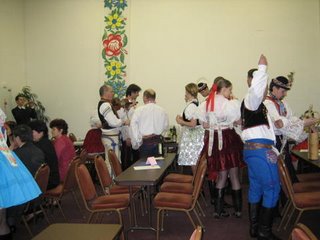 We settled at our table, which was near those of numerous kroj-clad characters, and ordered a bottle or two of wine. As I may have mentioned, Moravia is a wine-producing region and the Moravians take their wine very seriously. It is not much like French or California wine, but it is quite likeable as a rule.
We settled at our table, which was near those of numerous kroj-clad characters, and ordered a bottle or two of wine. As I may have mentioned, Moravia is a wine-producing region and the Moravians take their wine very seriously. It is not much like French or California wine, but it is quite likeable as a rule.
Pageantry-wise, the main event was a display of all the kroj. Each locale has its own special outfits, and although when you see this sort of thing in museums you get the impression that it is some sort of ancient ceremonial garb, as a rule it is relatively recent. I can’t speak specifically for Moravian kroj, but when I was researching nineteenth-century depictions of Bretons and Brittany (one of those side interests of mine), I learned that while people like to imagine that Breton peasant attire dates back to the middle ages, it largely came into something like its present form during the nineteenth century, when the peasants, although still impoverished, finally had enough money to develop elaborate costumes differentiated by village. To some extent the Bretons were still working out their local costumes in the 1950s. It is my understanding that the Norwegians are still inventing and standardizing local festive dress for any community that failed to do so 150 years ago (after all, there’s a market for this stuff both at home and abroad), and I am pretty sure that this is also the case for the Czech Republic and Slovakia. One has to have something distinctive to wear at folk festivals, after all.
I find all this fascinating and delightful, although I have to agree with Megan that in some cases the result is not what might be considered flattering. I do, in fact, think that if I ever get around to acquiring the Norwegian equivalent of kroj, I will have to decide which of the ancestral outfits are most appealing. After all, that sort of thing is expensive and I am never going to need three or four Norwegian folk costumes just to show that my ancestors lived in Norderhov, Vinger, and the greater Fyresdal area. I’ve never been to a Norwegian-American event, although it did occur to me to wonder whether a Norwegian outfit would have gotten me the kroj discount at the Brno folk ball.
Anyhow, Dawn took quite a few pictures of people doing the parade of kroj.
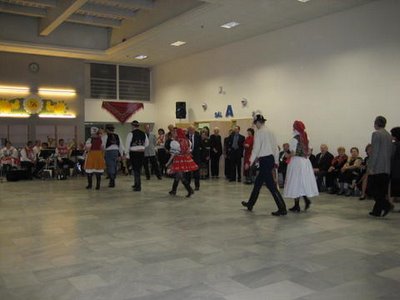
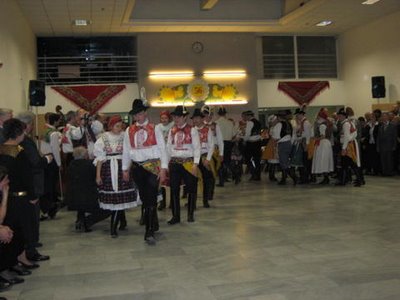
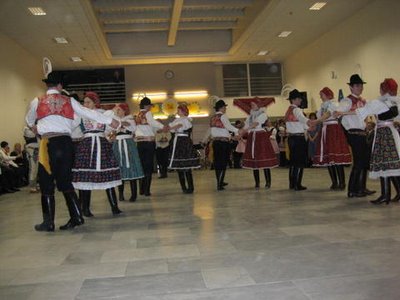
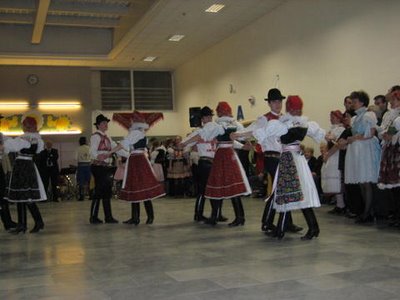
Once the kroj-wearers had all presented themselves to the rest of us, the dancing could really begin. For the most part, our group participated as spectators, but Jesse’s parents danced with great enthusiasm (and competence) and some of the rest of us ventured out there as well. Megan, for instance, found herself to be extremely popular with an unprepossessing person who appeared to be the only dancer in attendance determined to grope his partner on the dance floor. Megan seemed to take this all quite stoically, but after observing a certain amount of this, Jesse maneuvered us in their direction and at a break in the music deftly removed Megan from the dance floor (I followed hastily so as not to become the next victim). There was considerable disagreement as to the age of Megan’s pursuer. Alex believed him to be at least seventy, whereas Jesse’s mother and I put him at under fifty; I thought perhaps under forty but prematurely gray. His age is, of course, beside the point. He later wanted to dance with Dawn or me, but we turned him down. Being groped by complete strangers is not our idea of a good time.
For the most part, our group participated as spectators, but Jesse’s parents danced with great enthusiasm (and competence) and some of the rest of us ventured out there as well. Megan, for instance, found herself to be extremely popular with an unprepossessing person who appeared to be the only dancer in attendance determined to grope his partner on the dance floor. Megan seemed to take this all quite stoically, but after observing a certain amount of this, Jesse maneuvered us in their direction and at a break in the music deftly removed Megan from the dance floor (I followed hastily so as not to become the next victim). There was considerable disagreement as to the age of Megan’s pursuer. Alex believed him to be at least seventy, whereas Jesse’s mother and I put him at under fifty; I thought perhaps under forty but prematurely gray. His age is, of course, beside the point. He later wanted to dance with Dawn or me, but we turned him down. Being groped by complete strangers is not our idea of a good time.
After awhile we discovered that there was a cimbalom band performing downstairs. I’m not sure why the cimbalom bands are always put downstairs; the wind ensemble upstairs was perfectly acceptable, but some of us like cimbalom bands better and for that matter they are the subject of Jesse’s dissertation. So some of us went downstairs, where we found numerous dancers in kroj and a lot of people drinking wine at smaller tables. There did not seem to be any unoccupied place to sit. However, Dawn began conversing with another standee, and shortly thereafter this woman and I recognized one another from the January get-together. I had a long conversation with one of her friends, and then my original acquaintance invited our group to sit at her table, so we descended upon that table and were instructed to help drink a lot of Moravian wine.
From this point on, the remaining members of our party were in the midst of a constant stream of animated conversation and wine-drinking. I am no longer sure exactly what was discussed, but we were taught some sayings of unclear meaning, invited to stay in mountain cottages, encouraged to meet people’s adult children, entreated to come to future events, and so forth and so on. (Americans often claim that Czechs are cold and unfriendly, but my experience has always been quite the contrary, they are always taking a fancy to me or my companions and lavishing vast amounts of affectionate attention upon us, which can be disconcerting when one is used to standoffish American ways, but is nonetheless very pleasant.)
So, we enjoyed all this attention and the opportunity for Jesse, Dawn, and me to practice our Czech in a highly informal setting. As the end of the evening neared, we bade our companions good night and retrieved our goods from the coat check. But the upstairs band sounded strangely tempting, so next thing we knew, we were dumping our belongings on some empty chairs and getting back on the dance floor, which we didn’t leave until considerably later and after some encores and a conga line.
And that was the fabled Brno folk ball. It was much too exciting for me to get any sleep afterwards, so the next day I was a little droopy until all the coffee hit and caused me to bounce around the back of the bus like some sort of amphetamine-crazed teenager. But that’s another story and long past.
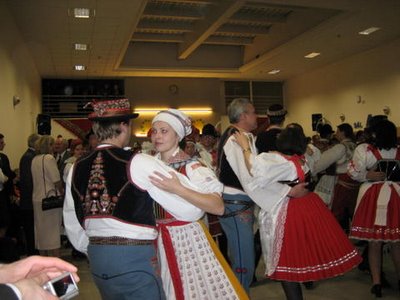 All photos by Dawn
All photos by Dawn
After all, Dawn gave me copies of her photos and Megan has posted some of hers on her blog. (I’m not sure what Jesse and Alex have done with theirs.)
I saved my ticket and program to this legendary folk ball, but have never been able to figure out where they went, which is a hindrance. In brief, the Brno folk music/dance society whose monthly get-together Jesse and I attended in January has an annual ball, and anyone who attends in kroj (regional costume) gets in for a reduced price. This year’s ball coincided with the visit of Jesse’s mother, stepfather, and brother, and came just before the Fulbright conference at Velké Bílovice, so a significant group of us attended, although I am afraid none of us dressed in kroj. (While those in kroj were numerous, they did not outnumber the rest of us.)
The doorkeepers were quite pleased to have eight Americans show up with a table reservation. This clearly struck them as a desirable phenomenon. Once given our tickets, we received welcoming shot glasses of white wine (some members of the party were a little disturbed that the used glasses were merely rinsed and reused, but perhaps we are needlessly devoted to hygiene).
The band was already playing by the time we arrived, and there was a decent crowd, but things hadn’t really gotten underway yet.
 We settled at our table, which was near those of numerous kroj-clad characters, and ordered a bottle or two of wine. As I may have mentioned, Moravia is a wine-producing region and the Moravians take their wine very seriously. It is not much like French or California wine, but it is quite likeable as a rule.
We settled at our table, which was near those of numerous kroj-clad characters, and ordered a bottle or two of wine. As I may have mentioned, Moravia is a wine-producing region and the Moravians take their wine very seriously. It is not much like French or California wine, but it is quite likeable as a rule.Pageantry-wise, the main event was a display of all the kroj. Each locale has its own special outfits, and although when you see this sort of thing in museums you get the impression that it is some sort of ancient ceremonial garb, as a rule it is relatively recent. I can’t speak specifically for Moravian kroj, but when I was researching nineteenth-century depictions of Bretons and Brittany (one of those side interests of mine), I learned that while people like to imagine that Breton peasant attire dates back to the middle ages, it largely came into something like its present form during the nineteenth century, when the peasants, although still impoverished, finally had enough money to develop elaborate costumes differentiated by village. To some extent the Bretons were still working out their local costumes in the 1950s. It is my understanding that the Norwegians are still inventing and standardizing local festive dress for any community that failed to do so 150 years ago (after all, there’s a market for this stuff both at home and abroad), and I am pretty sure that this is also the case for the Czech Republic and Slovakia. One has to have something distinctive to wear at folk festivals, after all.
I find all this fascinating and delightful, although I have to agree with Megan that in some cases the result is not what might be considered flattering. I do, in fact, think that if I ever get around to acquiring the Norwegian equivalent of kroj, I will have to decide which of the ancestral outfits are most appealing. After all, that sort of thing is expensive and I am never going to need three or four Norwegian folk costumes just to show that my ancestors lived in Norderhov, Vinger, and the greater Fyresdal area. I’ve never been to a Norwegian-American event, although it did occur to me to wonder whether a Norwegian outfit would have gotten me the kroj discount at the Brno folk ball.
Anyhow, Dawn took quite a few pictures of people doing the parade of kroj.




Once the kroj-wearers had all presented themselves to the rest of us, the dancing could really begin.
 For the most part, our group participated as spectators, but Jesse’s parents danced with great enthusiasm (and competence) and some of the rest of us ventured out there as well. Megan, for instance, found herself to be extremely popular with an unprepossessing person who appeared to be the only dancer in attendance determined to grope his partner on the dance floor. Megan seemed to take this all quite stoically, but after observing a certain amount of this, Jesse maneuvered us in their direction and at a break in the music deftly removed Megan from the dance floor (I followed hastily so as not to become the next victim). There was considerable disagreement as to the age of Megan’s pursuer. Alex believed him to be at least seventy, whereas Jesse’s mother and I put him at under fifty; I thought perhaps under forty but prematurely gray. His age is, of course, beside the point. He later wanted to dance with Dawn or me, but we turned him down. Being groped by complete strangers is not our idea of a good time.
For the most part, our group participated as spectators, but Jesse’s parents danced with great enthusiasm (and competence) and some of the rest of us ventured out there as well. Megan, for instance, found herself to be extremely popular with an unprepossessing person who appeared to be the only dancer in attendance determined to grope his partner on the dance floor. Megan seemed to take this all quite stoically, but after observing a certain amount of this, Jesse maneuvered us in their direction and at a break in the music deftly removed Megan from the dance floor (I followed hastily so as not to become the next victim). There was considerable disagreement as to the age of Megan’s pursuer. Alex believed him to be at least seventy, whereas Jesse’s mother and I put him at under fifty; I thought perhaps under forty but prematurely gray. His age is, of course, beside the point. He later wanted to dance with Dawn or me, but we turned him down. Being groped by complete strangers is not our idea of a good time.After awhile we discovered that there was a cimbalom band performing downstairs. I’m not sure why the cimbalom bands are always put downstairs; the wind ensemble upstairs was perfectly acceptable, but some of us like cimbalom bands better and for that matter they are the subject of Jesse’s dissertation. So some of us went downstairs, where we found numerous dancers in kroj and a lot of people drinking wine at smaller tables. There did not seem to be any unoccupied place to sit. However, Dawn began conversing with another standee, and shortly thereafter this woman and I recognized one another from the January get-together. I had a long conversation with one of her friends, and then my original acquaintance invited our group to sit at her table, so we descended upon that table and were instructed to help drink a lot of Moravian wine.
From this point on, the remaining members of our party were in the midst of a constant stream of animated conversation and wine-drinking. I am no longer sure exactly what was discussed, but we were taught some sayings of unclear meaning, invited to stay in mountain cottages, encouraged to meet people’s adult children, entreated to come to future events, and so forth and so on. (Americans often claim that Czechs are cold and unfriendly, but my experience has always been quite the contrary, they are always taking a fancy to me or my companions and lavishing vast amounts of affectionate attention upon us, which can be disconcerting when one is used to standoffish American ways, but is nonetheless very pleasant.)
So, we enjoyed all this attention and the opportunity for Jesse, Dawn, and me to practice our Czech in a highly informal setting. As the end of the evening neared, we bade our companions good night and retrieved our goods from the coat check. But the upstairs band sounded strangely tempting, so next thing we knew, we were dumping our belongings on some empty chairs and getting back on the dance floor, which we didn’t leave until considerably later and after some encores and a conga line.
And that was the fabled Brno folk ball. It was much too exciting for me to get any sleep afterwards, so the next day I was a little droopy until all the coffee hit and caused me to bounce around the back of the bus like some sort of amphetamine-crazed teenager. But that’s another story and long past.
 All photos by Dawn
All photos by Dawn
2 Comments:
Thanks for the post and great pictures. Unfortunately my photos didn't really turn out and I've never posted my notes from the event. They were somewhat more discursive than coherently descriptive and I didn't think they would be of much interest to the rest of the world. And since there weren't any special pictures, I figured a post was not necessary.
Regarding the friendliness of Czechs, it seems a matter of the self one presents on the street - you just don't go out of your way to greet and/or talk with people on the street here. I'm not sure how much of this is an effect of the Communist past and how much is an effect of urbanization. Most likely it is a combination of those and many more things. It is easy to mistake this way of interacting as unfriendliness, though in some cases it is. I'm not exactly sure how I feel about it anymore. It definitely seems to be an example of a 'mask' that one wears in public; however, at what point does this mask become the reality? To what extent is a mask not the "real" you? In our experience at the ball all of the hospitality we received was the result of a network of prior small personal interactions (which extend far beyond those who were present) and by no means, at least apart from the moment of recognition, a spontaneous occurence.
I agree people aren't inclined to talk with strangers on the street, but I don't find that urban Americans do a lot of talking to strangers on the street either (although perhaps somewhat more than Czechs).
And definitely our experience at the ball was entirely the result of having met people previously. Although Dawn and my initial conversations were with people we had not previously encountered, so there was something surprisingly spontaneous about that.
More about the larger topic to come...
Post a Comment
<< Home